- Home
- Deborah Blum
Love at Goon Park: Harry Harlow and the Science of Affection Page 14
Love at Goon Park: Harry Harlow and the Science of Affection Read online
Page 14
Harry liked to point out that this was a beautiful example of science catching up with everyday common sense. It was his favorite kind of psychology—the kind that made sense in the real world as well as in the laboratory. As he said, “An informal survey of neobehaviorists who are also fathers (or mothers) reveals that all have observed the intensity of the curiosity motive in their own child. None of them seriously believes the behavior derives from a secondorder drive. After describing their children’s behavior, often with a surprising enthusiasm and frequently with the support of photographic records, they trudge off to their laboratories to study, under conditions of solitary confinement, to study the intellectual processes of rodents.”
Harry liked the Butler box so much that he kept it, even when he was no longer himself doing intelligence studies. It would turn out to be a smart decision. When he became interested in mother love, Harry put baby monkeys inside the box and their cloth-soft surrogate mother outside. He knew that electric trains and strange scientists fascinated monkeys. None of that compared, though, to the way the baby monkeys would doggedly raise the panel to see their mother’s face. The little animals would open the window and open it and open it, over and over and over, until one by one the graduate students watching them dropped off to sleep. In one experiment, a baby monkey continued to seek those flickering glimpses of his mother for nineteen hours straight. It might have been longer, actually, but yet another student fell asleep as he watched the window flick up and down. The baby monkeys were so fixed upon seeing their mothers that Harry took to calling the Butler box a “love machine.”
You couldn’t watch the small monkey faces, their eyes anxiously searching for their mothers, without beginning to see love as a tangible force, a physical cord pulling tight between mother and child. You might even come to believe that love is so powerful that it can influence anything, including the brain. You might, if you were a scientist watching those monkeys, start thinking that the tireless blink of that window, the serious little face peering through it, had something to tell you.
FIVE
The Nature of Love
Growing up is very gruesome / by singletons or else by twosomes /
And after love has long miscarried / The twosomes find that they
are married.
Harry F. Harlow, “The Gruesome Twosomes,” undated
ALREADY A FEW OTHER REBELLIOUS scientists were arguing that love and intelligence could be connected, literally, from dot to dot. These were not animal researchers but doctors and psychologists working directly with children in orphanages and foundling homes. They suggested that social intelligence and cognitive intelligence might be linked. The end point was that children raised without affection might lose more than their ability to relate to others. Isolation and loneliness might dull the brain in other ways—and that dimming down might even show up on the Stanford-Binet Intelligence Scale.
To those opposing the idea—and Lewis Terman was definitely among them—the concept was ridiculous. Sentimental. And unnerving. If the healthy development of the brain depended on being loved, wouldn’t that suggest that affection and nurturing were akin to breathing, basic to life itself? If that were so, wouldn’t we be impossibly vulnerable to loneliness or isolation or the vagaries of parents and home?
Terman didn’t see the brain as anything like such an unstable structure. The human brain gleamed in his mind like finished marble, sculpted by genes, polished by superior biology. If you had inherited good genes—the kind possessed by Clara Mears Harlow—you possessed “splendid hereditary equipment” and were born to be smart. If not, you were destined to be average, or worse. Children who inherited the good genes looked good on IQ tests. Children who inherited less-splendid genetic material didn’t. Terman’s vision didn’t allow for a smart child who faltered in a hostile environment. It allowed little room for environmental influences at all, including the difference between a warm and loving home and an unfriendly one.
By such standards, a slow-maturing baby could be judged harshly. If an infant seemed behind the curve, some pediatricians would advise that the child be institutionalized. The parents could then try for a better one. Arnold Gesell, one of the best-known pediatricians of the 1930s, had a reputation for recommending that approach. Gesell, a Yale University psychologist, remains famous in baby-doctor circles even today. He was a pioneer in working out developmental timetables—all those charts that dedicated parents follow in anticipation of when their babies should start smiling or rolling over. And Gesell used to say that the inborn development tendencies were so strong that parenting styles didn’t matter that much. A child was going to turn out as his genes dictated, so that he “benefits liberally from what is good in our practice, and suffers less than he logically should from our unenlightenment.”
Gesell opposed the adoption of very young babies. He thought prospective parents should wait to see whether a child suffered from inborn brain deficiencies. It didn’t occur to him that being institutionalized might foster deficiencies. But when he evaluated those older orphans, he quite often found them less sharp than the parents had hoped. Another Yale psychiatrist, Milton Senn, complained that Gesell’s habit of diagnosing mental defects in institutionalized children kept them from being adopted at all. Senn recommended early adoption as a preventative measure against mental retardation. Gesell had a ready answer for that: He accused Senn of not understanding child development.
And yet there were these annoying studies that kept turning up here and there. In New York City, one outspoken psychiatrist was making the most inexplicable findings about affection and IQ. The researcher in question was named William Goldfarb, who had been studying children in the city’s Jewish foundling homes, trying to assess their social and intellectual development. Goldfarb had been one of the first researchers to worry that social isolation could permanently affect children’s ability to connect with other people. He also tracked the IQ scores of children raised in foundling homes and compared them with the scores of children raised in foster homes. His findings directly challenged the notion of superior genetic lines.
The mothers who had left their children in the foundling and foster homes had to fill out an education and background survey. “It is a matter of some importance,” Goldfarb insisted, “that the mothers of the institution children are significantly superior to the mothers of family [foster] children in occupational background.” With this statement, he was deliberately taking on the Terman point of view, the belief that superior parents produced superior children. Just in case anyone had missed his drift, Goldfarb hammered it again. The mothers of many children placed in institutions came from the higher social classes. Their children were the result of unplanned and unwanted pregnancies. By contrast, many of the foster children came from a less impressive family background. They were placed in foster homes due to neglect, the death of a parent, desertion.
If you followed the laws of inherited intelligence, you would expect that the children given to foundling homes would inevitably be smarter than the fostered children. After all, Goldfarb said, “One might even infer that the mothers of the institution children are also superior in intelligence.” What he found and reported, though, was the opposite. Over all, the fostered children averaged 96 on the IQ scale. The foundlings averaged 72, falling into the dreaded feebleminded category. The foundlings were less determined, less interested, less willing to explore. What could have happened to these children of supposedly bright and capable mothers, then? Goldfarb thought they were probably diminished by the sterile, unnourished nature of the homes. The places were stripped down, after all, and understaffed. The children were raised in an atmosphere of clean rooms, carefully ordered play, many domestic chores, and very basic instruction. It was hard to imagine that a child would thrive intellectually in such a world.
Goldfarb, though, also worried about another kind of diminishing effect—less obvious but, he suspected, no less real. He reported that many of the foundlings were so
apathetic that they appeared as shadows of children. They were silent and withdrawn. Some could hardly be tested because it was so difficult to awaken them into focused participation. One problem was that no one was interested in them, he said. The caretakers seemed indifferent. But was that surprising? Goldfarb asked. Is an adult ever interested in a child who doesn’t stir his heart? An odd kind of chicken or egg issue underlies that query. Does affection for another person create interest in him or does interest lead to affection?
When it came to the foundlings, Goldfarb had an idea that interest and affection twined together, tight as a rope, almost inseparably. All of us, even as babies, are a bundle of feelings and desires, he said. Our positive emotions grow best in an interactive sense, fostered by how we react to others and how they respond to us. A baby, a child, even an adult, needs at least one person interested and responsive. We grow best in soil cultivated by someone who thinks we matter. A baby, in particular, needs such encouragement and will do his best to please in return. Infants imitate adults and coo back to them and smile back, and through those ordinary exchanges they have their best chance at developing into an engaged and confident child. Without such affectionate interaction, Goldfarb thought, those positive responses would fail to flourish. The exterior child would look healthy; the interior would be stunted. Lacking a strong caretaker relationship, a child surrounded by other children in an orphanage could still grow up in a kind of curious developmental isolation.
Goldfarb believed that foundling children had a “never sated craving for affection.” Because no one cared about them, they buffered themselves by not caring either. They withdrew from others and they withdrew from tasks and challenges, including those that you might consider intelligent life skills such as reading, and math, and those analytical challenges built into the Stanford-Binet IQ test. So what did their test scores reveal? Mental deficiency or intellectual despondency?
That question was taken up at the University of Iowa’s Child Welfare Research Station. In the late 1930s, the Iowa psychologists were focusing—ahead of their time—on the interaction of genes and environment. Perhaps Goldfarb’s closest counterpoint there was a famously gentle-mannered psychologist named Harold Skeels. His research had started with a focus on language development. Skeels had also been following children raised in foundling homes and testing them on the Stanford-Binet scale, tracking their language skills, as they grew older. What intrigued—and worried—him was the same thing that had troubled Goldfarb. Skeels wasn’t seeing the normal rising curve of language skills that he had expected. The longer children stayed in the homes, the more their verbal IQ scores dragged downward.
No matter how he turned those results around, the one constant was that the foundlings felt desperately unwanted. Skeels also began to wonder whether a lack of loving attention could impair intellectual functioning. He tried a simple test. He took a group of preschool children from a warehouse-style orphanage and sent them to a friendly nursery school for several hours a day. Skeels then compared them to toddlers who stayed at the foundling home entirely during the next year. The children who did not attend nursery school outside the foundling home suffered the usual IQ drop. As he reported, those who went to preschool didn’t suddenly leap upward in verbal IQ. But they didn’t tumble, either. Their scores held steady. Compared to the foundlings, still sliding down the scale, the preschool group thus looked a lot smarter.
The nursery school, Skeels reasoned, provided only casual affection. What he needed—if he was right and affection mattered—was to provide something like mothering. Because the children’s mothers had long vanished, he needed a good loving substitute. This led to Skeels’s most unusual—some might say risky—experiment. He took thirteen children, all under the age of two and a half, from an orphanage and put them in a home for older “feebleminded” girls, those who fell below the razor wire Stanford-Binet line of 80. Skeels carefully selected girls who were clearly functional and warm in nature. Each child was “adopted” by one of the older girls, a few by an attendant, who took over mothering functions. And mother they did: They cuddled and kissed, played with and comforted the children in their care. Over nineteen months, the average IQ of the mothered toddlers rose from 64 to 92 on the Stanford-Binet, in other words, from feeble-minded to measurable intelligence. There was indeed something, still mysterious, about isolation that seemed to make the brain falter.
But what was it? Later in his career, Harry Harlow would take on the effects of social isolation as directly as anyone in psychology. For the moment, the issue merely hummed at the edges of his awareness. The power of love and loneliness was an interesting academic question, even a troubling one. He wasn’t ready to take it on; he was still obsessed with questions of working intelligence. But, as it turned out, the effects of isolation were about to gain his attention in a personal sense. He might not be ready to study loneliness—although that, too, would come—but he was heading for a sharp lesson in the shape of life without love.
We can create isolation in institutions. We can, it seems, also create it while still surrounded by family. At this moment, Harry’s professional life seemed to him to be the best thing in his life—his intelligence studies were gaining recognition. Terman was finally impressed, even predicting that his former student would rise to the top of the American Psychological Association. It would be many years before Harry would admit that he might have been wrong about what was best in his life. After he retired, he would talk about how hard it was to get love right. We could be told, we could be educated, but we still had to fumble our way through the lessons of the heart. The challenge would lead him to the rare admission that it might take a greater power than even science. “People have to learn quite a bit by themselves,” Harry said simply. “Christ passed on to people quite a few tantalizing tidbits about the importance of love and left the rest of us to learn, little by little, as God sees fit.”
Harry’s oldest son, Robert, remembers those years when his parents’ marriage began to break as almost a crazy quilt, a patchwork of good times and bad. The Harlows had built their house on Lake Mendota, a rectangular building made beautiful by windows filled with the glimmer of light on water. On weekend mornings, Harry and Clara would have coffee together. Bobby, as Robert was called then, would sit near his parents in a little wooden chair that had belonged to his mother and had her name painted on the back. Robert still calls it the Clara chair. He would hold as still as he could, a small, fair-haired five-year-old in the Clara chair, listening to his parents. “If I was good, they’d let me come over and each give me a spoonful of coffee. It must have been full of cream because it was very mild.” He was a quiet little boy, undemanding, good enough to get coffee regularly, and his mother used to call him her perfect child.
Clara was still a lover of friends and company. The Harlows hosted bridge and dinner parties. Bobby would sit on the stairs, “listening to the sound of bridge cards getting shuffled.” He holds onto other memories besides the dry whisper of cards. He recalls swimming in the lake during the summer months; making his mother an ashtray out of tar from the driveway, which melted into a black sticky puddle; of his dad’s aversion to house and lawn work. There was one week when the whole family was felled by illness. Paul Settlage wrote to his friend Abe Maslow, back in New York, that “recently, Harry has been having a tough time of it. Bobby had the mumps, and then Clara caught it, and then Bobby became sick twice more, and during this time, Harry discharged the domestic duties while being more or less in the toils of flu himself. The other day he could hardly stand up. The man always has had a certain dogged persistence.”
On December 10, 1942, Harry and Clara’s second son, Richard Frederick, was born. Bobby’s memories become less happy after that point. It was as if that change, just the one more child, pushed Harry past what he could handle. He had no spare energy. His research was becoming an obsession, the laboratory seemed to be his home of the moment. Settlage saw this as a visible change, a shift into tota
l absorption. “Harry,” he told Maslow, “is working harder than ever.” There was a new driven intensity. And with new demands at home, Harry seemed to feel stretched too far—like a fine wire, thinning as it pulled. It was barely six months after Rick was born, according to Clara, that Harry began to withdraw from the family. He “increasingly immersed himself in his work and became silent and uncommunicative” at home. He was up early and gone, home late, off to the lab every day, weekends included.
Finally, Clara began insisting that, at least, Harry should take Bobby with him on weekends. He should have some time with his son, she argued. Even lab time was better than no time. Now grown, a father himself, Robert Israel still remembers those visits to the box factory lab: “He’d take me over there and I’d watch him do experiments, slide the door up and down, arrange the puzzles. I loved being there. I could wander around and anytime I wanted I could feed the monkeys. There was a container of dried fruit and another of peanuts and I’d get a handful. He taught me how to hold the food so I wouldn’t get scratched.” They didn’t really do the father-son thing that Clara had envisioned. At the lab, even with his small son in tow, Harry’s mind was only on the research. “He didn’t talk to me. When he was at the lab, he was focused on his work. But I was comfortable because Dad was there. I was happy in his world. My brother, who’s three years younger, I don’t think he has a single memory of Dad from his childhood.”

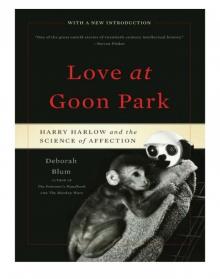 Love at Goon Park: Harry Harlow and the Science of Affection
Love at Goon Park: Harry Harlow and the Science of Affection The Poison Squad
The Poison Squad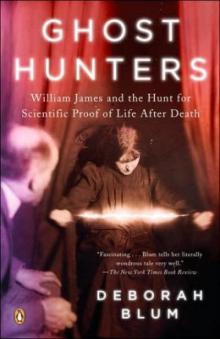 Ghost Hunters: The Victorians and the Hunt for Proof of Life After Death
Ghost Hunters: The Victorians and the Hunt for Proof of Life After Death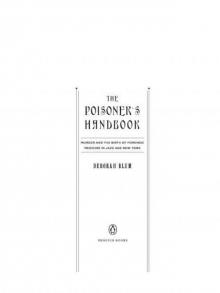 The Poisoner's Handbook
The Poisoner's Handbook Angel Killer
Angel Killer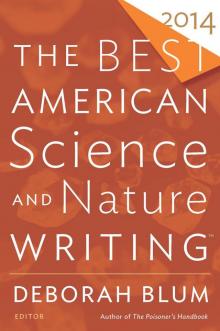 The Best American Science and Nature Writing 2014
The Best American Science and Nature Writing 2014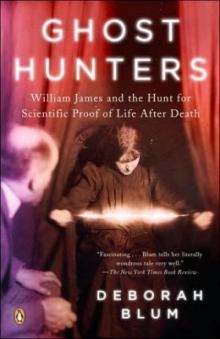 The Ghost Hunters
The Ghost Hunters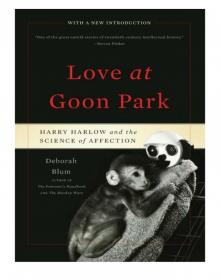 Love at Goon Park
Love at Goon Park